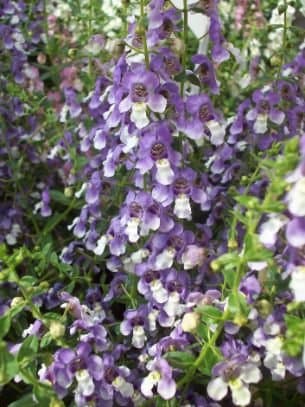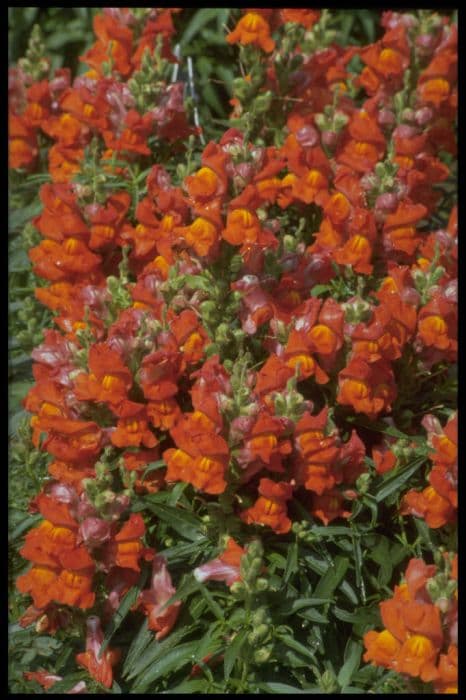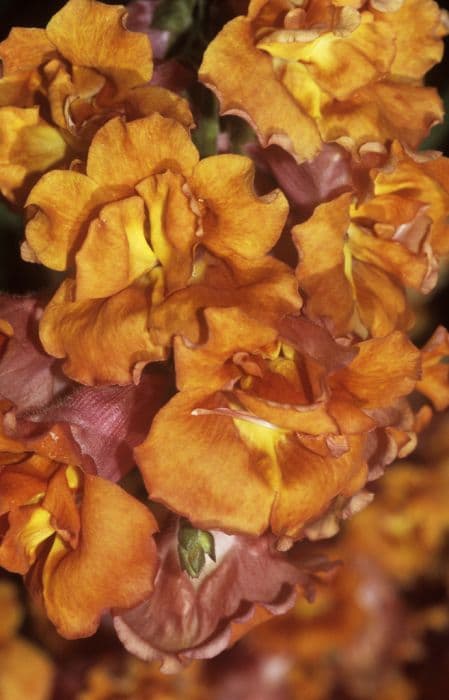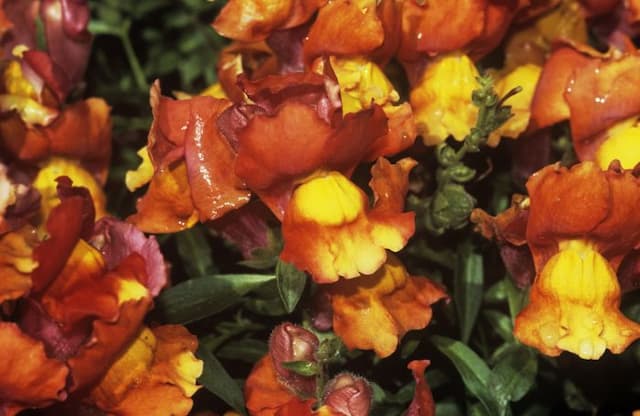Penstemon 'Pensham Capricorn Moon' Penstemon 'Pensham Capricorn Moon' (Pensham Series)

ABOUT
A selection with pale pink flowers. These have white throats, marked with dark pink. Height to 60cm
About this plant
 Names
NamesFamily
Plantaginaceae
Synonyms
Beardtongue
Common names
Penstemon 'Pensham Capricorn Moon'.
 Characteristics
CharacteristicsLife cycle
Perennials
Foliage type
Deciduous
Color of leaves
Green
Flower color
Purple
Height
2 feet (60 cm)
Spread
2 feet (60 cm)
Plant type
Herb
Hardiness zones
8
Native area
North America
Benefits
 General Benefits
General Benefits- Attracts Pollinators: The plant is known to attract bees and butterflies, which are beneficial for pollination.
- Drought Resistance: Once established, it is drought-tolerant, reducing the need for frequent watering.
- Long Blooming Period: Penstemon 'Pensham Capricorn Moon' produces flowers for an extended period, typically from early summer to fall.
- Easy to Grow: It is generally an easy plant to care for, requiring minimal maintenance.
- Cold Hardy: This variety can withstand relatively cold temperatures, making it suitable for many climates.
- Aesthetic Appeal: The plant offers aesthetic value to gardens with its vibrant purple flowers and attractive foliage.
- Versatile Landscaping: Suitable for borders, containers, and cottage gardens due to its size and flowering habit.
 Medical Properties
Medical PropertiesThis plant is not used for medical purposes.
 Air-purifying Qualities
Air-purifying QualitiesThis plant is not specifically known for air purifying qualities.
 Other Uses
Other Uses- Photography backdrop: Due to its striking flowers, Penstemon can provide a colorful backdrop for garden photography, enhancing the visual appeal of photos.
- Artistic inspiration: The vibrant hues and interesting shapes of Penstemon flowers can inspire artists and be used as subjects in paintings and illustrations.
- Educational tool: Botany enthusiasts may use Penstemon as a model plant to study and demonstrate the characteristics of the Plantaginaceae family for educational purposes.
- Garden Theming: Penstemon 'Pensham Capricorn Moon' can be used to create a moon garden theme, where its pale blooms can reflect moonlight and create an ethereal nocturnal landscape.
- Mood enhancement: The presence of Penstemon in a garden can help boost mood through its aesthetic appeal and by providing a sense of care and accomplishment in gardeners.
- Wedding decor: Sprigs of Penstemon can be used in wedding bouquets or as table decorations to add a touch of natural elegance to ceremonies and receptions.
- Dye source: Additionally, hobbyists may experiment with using the colored parts of Penstemon flowers as a natural colorant for dying fabrics or paper.
- Culinary garnish: Although not commonly consumed, the colorful blossoms of Penstemon can occasionally be used as an edible garnish to decorate dishes and desserts for a unique presentation.
- Floral crafts: People can dry Penstemon flowers and use them in creating everlasting floral arrangements, wreaths, or potpourri mixtures.
- Bee hotels: Planting Penstemon near bee hotels can attract pollinators, providing them with essential nectar and supporting local ecosystems.
Interesting Facts
 Feng Shui
Feng ShuiThe Beard Tongue is not used in Feng Shui practice.
 Zodiac Sign Compitability
Zodiac Sign CompitabilityThe Beard Tongue is not used in astrology practice.
 Plant Symbolism
Plant Symbolism- Attraction and Charm: Penstemons are often associated with allure due to their vibrant, tubular flowers that can mesmerize onlookers and are believed to symbolize the idea of drawing in what one desires.
- Diversity and Adaptation: With the variety of Penstemons and their ability to thrive in different environments, they symbolize versatility and the ability to adapt to changing circumstances.
- Health and Vitality: The Penstemon's robust nature and the way it attracts pollinators can be seen as a symbol of good health and vitality.
- Strength and Persistence: Given their hardy nature and ability to withstand various conditions, Penstemons can represent inner strength and the persistence to overcome challenges.
- Communication and Expression: The flower's tubular shape is sometimes seen as a metaphor for communication, symbolizing openness and the expression of thoughts and feelings.
 Water
WaterBeardtongue, commonly known as Penstemon 'Pensham Capricorn Moon', should be watered deeply once a week, providing enough water to soak the root zone. During hot, dry spells, increase watering to twice per week, ensuring that the soil dries out between watering to prevent root rot. Use about 1 gallon of water per plant for each watering session, adjusting for rainfall. Decrease watering frequency to every other week in the fall as the plant prepares for dormancy. It is best to water in the morning to reduce evaporation and the risk of fungal diseases.
 Light
LightBeardtongue thrives in full sun conditions receiving at least 6 to 8 hours of direct sunlight daily. An ideal spot is in an open area away from tall trees or buildings that might create excessive shade. Plants situated in too much shade may become leggy and produce fewer flowers.
 Temperature
TemperatureBeardtongue prefers moderate temperatures and can generally tolerate a range between 40°F to 85°F. Ideal growth occurs when daytime temperatures are around 70°F to 75°F. Winter temperatures should not fall below 20°F to avoid frost damage to the plant.
 Pruning
PruningPrune Beardtongue in late winter or early spring to remove any dead or damaged stems and encourage bushy growth. Deadheading spent blooms throughout the growing season will promote further flowering. Prune back by approximately one-third after the first flush of flowers to rejuvenate the plant and encourage a second bloom period.
 Cleaning
CleaningAs needed
 Soil
SoilBeardtongue thrives in well-draining soil enriched with organic matter, with a pH range between 6.0 and 8.0. A mix of two parts garden soil, one part peat moss or compost, and one part perlite or coarse sand is ideal for ensuring proper drainage and fertility.
 Repotting
RepottingBeardtongues should be repotted every 2-3 years to refresh the soil, avoid root crowding, and support their growth. Repotting is best done in the spring as they emerge from dormancy.
 Humidity & Misting
Humidity & MistingBeardtongue prefers moderate humidity levels but is quite adaptable and can tolerate both low and high humidity conditions as long as they are not extreme.
 Suitable locations
Suitable locationsIndoor
Place in bright, indirect light and ensure good air circulation.
Outdoor
Plant in full sun to partial shade, in well-drained soil.
Hardiness zone
5-9 USDA
 Life cycle
Life cycleThe Penstemon 'Pensham Capricorn Moon' begins its life as a seed, typically planted in well-drained soil and requiring a period of stratification—cold treatment—to stimulate germination. Upon germination in early spring, it develops into a seedling with basic root structure and shoots. As the plant matures, it grows into a clump-forming perennial, with stems reaching up to flowering height and leaves expanding to create photosynthetic energy. During late spring to summer, it produces bell-shaped flowers that attract pollinators and may set seeds if fertilized. After blooming, depending on the climate, the plant may either become dormant in winter, dying back to the ground, or in milder climates, it may retain some of its foliage. Over the years, the plant will continue to grow and may need division every few years to maintain health and vigor.
 Propogation
PropogationPropogation time
Spring to Early Summer
The most popular method of propagating Penstemon 'Pensham Capricorn Moon' is through semi-ripe cuttings. This process is typically done in late summer when the stems are partially matured but still pliable. To propagate, choose a healthy stem and make a cut below a node, creating a cutting that is about 2 to 4 inches long (5-10 centimeters). Remove the lower leaves to expose a small section of the stem. Dip the cut end into rooting hormone powder to enhance root development before planting the cutting into a pot filled with a moist, well-draining potting mix. Cover the pot with a plastic bag or place it in a propagator to maintain humidity, and keep it in a warm location with indirect sunlight. Roots usually develop within a few weeks, after which the cutting can be transplanted into a larger pot or into the garden.









